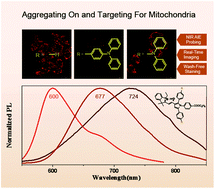Real time bioimaging for mitochondria by taking the aggregation process of aggregation-induced emission near-infrared dyes with wash-free staining†
Abstract
Fluorescent probing is one of the most powerful methods for bioimaging and/or detecting certain biological species. However, the problem of aggregation-caused quenching in aqueous environments limits the development of high performance fluorophores. In this study, three compounds were designed from triphenylpyrrole (TPP) derivatives with aggregation-induced emission (AIE) characteristics and were applied to real-time mitochondrial imaging. These TPP derivatives emitted near-infrared (NIR) signals by using indolium as an acceptor, both pyrrole and triphenylamine as donors, and ethenylidene as a π-bridge between the acceptors and donors. The combination of AIE features with NIR emission provides a wash-free procedure for staining the mitochondria in various live cells in less than 10 s. Moreover, the process of signal turn-on could be tracked by taking full advantage of the slow aggregation behavior of the dyes. In addition, the dyes also showed excellent photostabilities under laser irradiation for up to 6 h.

- This article is part of the themed collection: Recent Progress on Aggregation-Induced Emission


 Please wait while we load your content...
Please wait while we load your content...